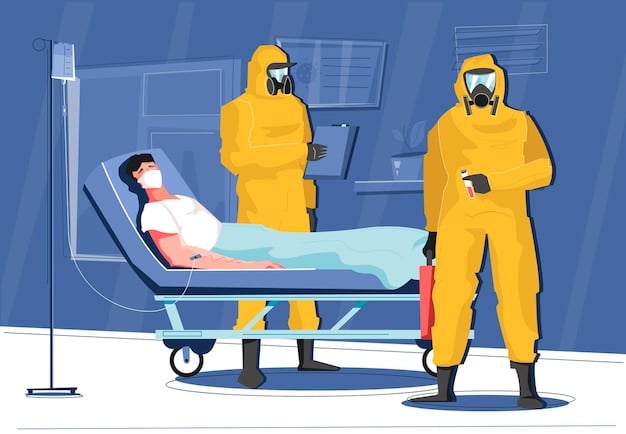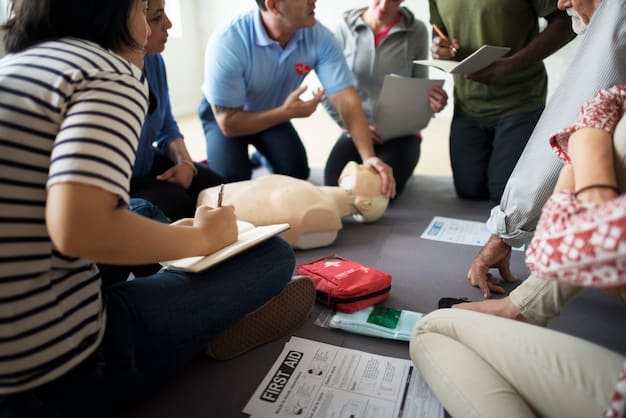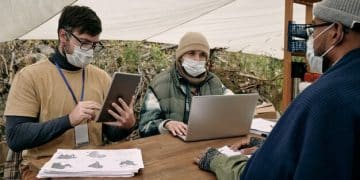Public Health Emergency Preparedness: Are We Ready for the Next Crisis?

Public Health Emergency Preparedness is crucial for mitigating the impact of crises; this article examines current preparedness levels and identifies gaps to enhance resilience.
Are we truly ready to face the next major public health emergency? The COVID-19 pandemic exposed vulnerabilities in our systems, underscoring the urgent need for robust public health emergency preparedness. This article delves into the current state of preparedness, identifies critical gaps, and explores strategies to bolster our defenses against future crises.
Understanding Public Health Emergency Preparedness
Public health emergency preparedness involves the comprehensive planning, training, and resource allocation necessary to effectively respond to and mitigate the impact of public health emergencies. These emergencies can range from infectious disease outbreaks to natural disasters and bioterrorism threats.
Effective preparedness requires a multi-faceted approach, involving collaboration among various stakeholders, including government agencies, healthcare providers, community organizations, and the public. It also demands a proactive mindset, anticipating potential threats and developing strategies to address them before they escalate into full-blown crises.
Key Components of Preparedness
Preparedness is made up of certain key components. Understanding these components is crucial for anyone involved in public health or emergency response.
- Surveillance and Detection: Establishing robust surveillance systems to detect potential threats early on.
- Risk Assessment: Identifying and evaluating potential hazards and vulnerabilities.
- Planning and Coordination: Developing comprehensive emergency response plans and ensuring effective coordination among stakeholders.
- Communication and Education: Communicating risks effectively to the public and providing education on preventive measures.
Without any of these components, emergency preparedness is significantly weakened. All components must come together to build a solid backbone for use during a public health incident.
In conclusion, understanding the concept well is fundamental to building a robust and resilient public health system. By effectively preparing for potential emergencies, we can minimize their impact and protect the health and well-being of our communities.

Lessons Learned from Past Crises
Examining past public health crises offers invaluable lessons that can inform and improve our current preparedness strategies. The COVID-19 pandemic, the Ebola outbreak, and other major incidents have highlighted both strengths and weaknesses in our response capabilities.
By analyzing these historical events, we can identify areas where we excelled and areas where we fell short, ultimately leading to more effective and targeted preparedness efforts. Understanding what’s happened in the past is key to facing what is to come.
The COVID-19 Pandemic
The COVID-19 pandemic serves as a stark reminder of the devastating impact that infectious diseases can have on global health and economies. It exposed vulnerabilities in our healthcare systems, supply chains, and communication strategies.
- Supply Chain Disruptions: Shortages of PPE, ventilators, and other essential medical supplies hampered response efforts.
- Communication Challenges: Conflicting information and misinformation undermined public trust and compliance with preventive measures.
- Healthcare System Strain: Overwhelmed hospitals and healthcare workers struggled to provide adequate care to the surge of patients.
Therefore, learning from the past is important to mitigate the negative impacts of the future. Building on past mistakes is how to improve and look toward a better future.
In summary, reflecting on past public health crises provides critical insights that can enhance our preparedness strategies. By addressing the shortcomings and building on the successes of previous responses, we can create a more resilient and effective public health system.
Current State of Preparedness in the US
The United States has made significant investments in public health emergency preparedness since the September 11th attacks and the subsequent anthrax scare. However, there are still areas where improvements are needed to ensure we are adequately prepared for future crises.
Federal, state, and local agencies play crucial roles in preparedness efforts, but coordination and collaboration can be challenging. Addressing these challenges is essential to optimize our response capabilities.
Federal Initiatives and Funding
The federal government provides funding and guidance to state and local health departments to support preparedness activities. However, funding levels have fluctuated over time, impacting the sustainability of these efforts.
Preparedness requires continued investment and attention at all levels of government. It is important to properly fund projects that address emergency preparedness. Without funding that preparedness will slowly erode.
State and Local Preparedness Efforts
State and local health departments are on the front lines of emergency response, implementing preparedness plans and coordinating with local stakeholders. The levels of preparedness vary significantly across states and localities, depending on resources and priorities.
Local health officials are generally the first line of defense in most emergencies, they are the first to visit the scene and assist in mitigation. Because of this, local health efforts are incredibly important, especially at the state level.

In conclusion, while the United States has made progress in public health emergency preparedness, there are still gaps that need to be addressed. By strengthening federal, state, and local efforts, we can better protect our communities from the impact of future crises.
Identifying Critical Gaps in Preparedness
Despite the progress made in public health emergency preparedness, several critical gaps remain that could hinder our ability to effectively respond to future crises. Addressing these gaps is essential to building a more resilient and responsive public health system.
These gaps span various areas, including funding, infrastructure, workforce, and communication. A holistic approach to preparedness must address all of these areas to ensure a comprehensive and coordinated response.
Funding Shortfalls and Resource Constraints
Inadequate funding and resource constraints limit the capacity of public health agencies to conduct preparedness activities, such as training exercises, equipment maintenance, and community outreach.
Funding is what keeps emergency preparedness in place. Without proper funding, emergency preparedness gradually declines which leaves room for mistakes and inefficiencies.
Infrastructure and Technology Deficiencies
Outdated infrastructure and technology can impede real-time data sharing, situational awareness, and communication during emergencies. Investing in modern systems is crucial for improving response capabilities.
- Data Sharing Challenges: Difficulty sharing information between agencies and jurisdictions.
- Outdated Communication Systems: Reliance on outdated communication systems that are vulnerable to disruptions.
- Lack of Interoperability: Incompatibility between different systems and platforms.
Communication is critical to ensure a coordinated mitigation effort. Without communication, the mitigation effort can experience delays and overall inefficiencies.
In summary, without improvements in public health, mitigation and emergency efforts are often slowed down and become less effective. The key is to solve those problems and work towards improvement.
Strategies for Enhancing Preparedness
To bolster our defenses against future public health emergencies, we must implement proactive strategies that address the identified gaps and strengthen our overall preparedness capabilities. These strategies should focus on improving funding, infrastructure, workforce development, and communication.
A comprehensive approach to preparedness requires coordinated efforts at all levels of government, as well as collaboration with private sector partners and community stakeholders. This collaborative effort ensures a unified and effective response to emergencies.
Investing in Public Health Infrastructure
Upgrading public health infrastructure with modern technologies and equipment is essential for improving situational awareness, data sharing, and communication during emergencies.
Modern equipment generally has faster processing times and can make the effort to disseminate information to the public faster, which is key. Also, most modern equipment has redundancy which allows for minimal downtime.
Strengthening the Public Health Workforce
Investing in training and recruitment programs can help build a skilled and diverse public health workforce capable of responding to a wide range of emergencies. It is never a bad idea to invest in your people.
- Cross-Training Initiatives: Providing training to healthcare workers and volunteers on emergency response protocols.
- Recruitment and Retention: Offering incentives and support to attract and retain qualified public health professionals.
- Leadership Development: Developing leadership skills among public health professionals to effectively manage emergency response efforts.
The preparedness will be more effective. The more trained personnel available to mobilize the better they will be at mitigating any issues that arise during the event.
In conclusion, by implementing proactive strategies and prioritizing investments in public health infrastructure, workforce development, and community engagement, we can enhance our preparedness and better protect our communities from the impact of future crises.
The Role of Community Engagement
Community engagement is a cornerstone of effective public health emergency preparedness. Empowering individuals and communities to take proactive steps to protect their health and well-being is crucial for building resilience.
Community-based preparedness initiatives can help promote awareness, build trust, and foster a sense of shared responsibility. When properly engaged, a community can rally together during an event to help mitigate the issues at hand.
Promoting Awareness and Education
Public awareness campaigns can educate individuals about potential threats, preventive measures, and emergency preparedness resources. The more informed the public, the better they are at mitigating any public health scare.
Education is arguably the best way to have the public ready. Education can be in the form of reading literature and simulated disasters.
Building Trust and Collaboration
Establishing strong relationships between public health agencies and community organizations is essential for building trust and fostering collaboration during emergencies.
This collaboration can take on many forms such as planning meetings, volunteer opportunities, and simulated disaster relief scenarios.
In summary, community involvement is an important part of public health preparedness. A great way to increase community involvement is to offer classes and training to community members to allow them to better serve themselves and each other during an event.
| Key Point | Brief Description |
|---|---|
| ⚠️ Preparedness | Planning, resources, and training for effective emergency response. |
| 🔬 Surveillance | Early detection of potential health threats and risks. |
| 🤝 Coordination | Collaboration among agencies, healthcare, and communities. |
| 📢 Communication | Effective information sharing with the public. |
Frequently Asked Questions
▼
It involves planning, training, and resource allocation to respond effectively to public health emergencies and events. Public health seeks to avoid and mitigate negative outcomes for the public at large.
▼
It promotes awareness, trust, and shared responsibility, empowering individuals to protect themselves and support the community during crises. An engaged community can participate in various public health exercises.
▼
Key components include surveillance, risk assessment, planning, and communication. All of these components are key to ensuring the public is safe and properly informed during an event.
▼
Infrastructure can be improved by upgrading technologies for better data sharing. A great way to do this is with proper funding for those types of projects. Without funding for infrastructure things can’t improve.
▼
The public health departments are the entities who are generally considered the first line of defense. Because of this, they play a very important role. They assess risk and deploy resources.
Conclusion
In conclusion, while advancements have been made in public health emergency preparedness, continued vigilance and proactive measures are essential to ensure we are ready for future challenges. By addressing existing gaps, investing in infrastructure and workforce development, and fostering community engagement, we can create a more resilient and responsive public health system.





